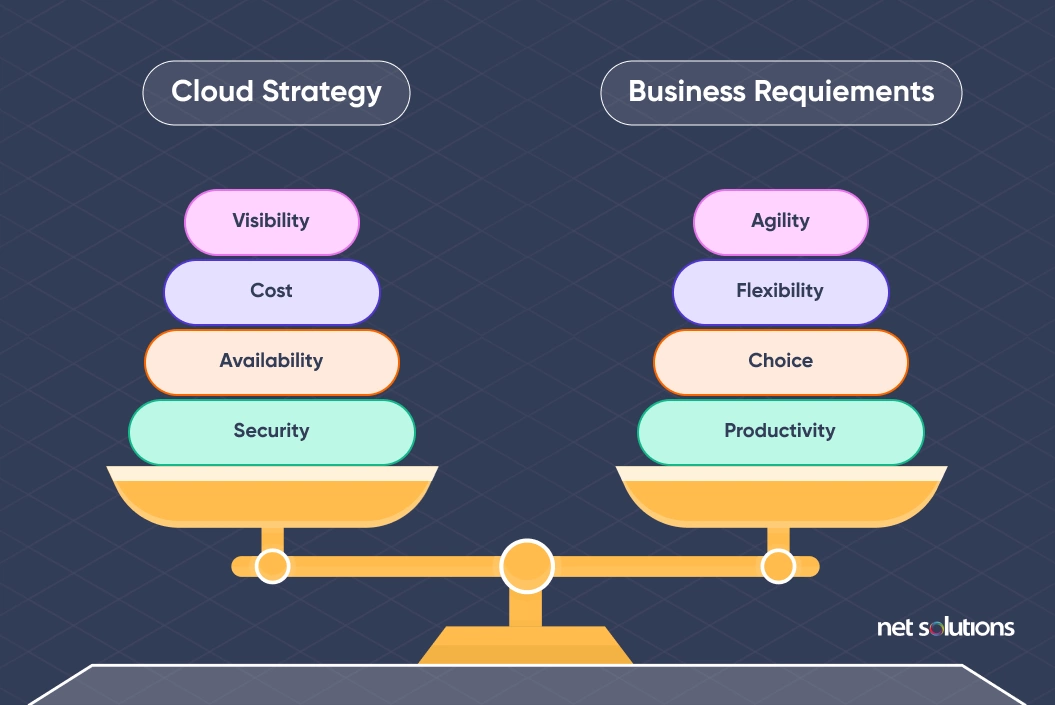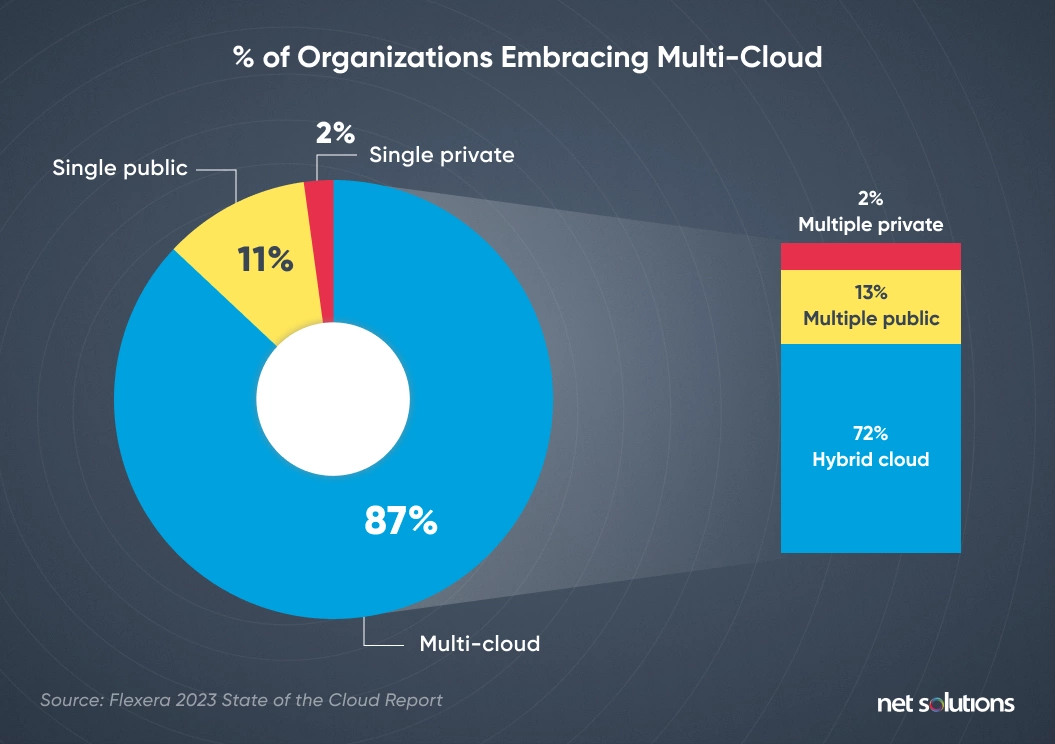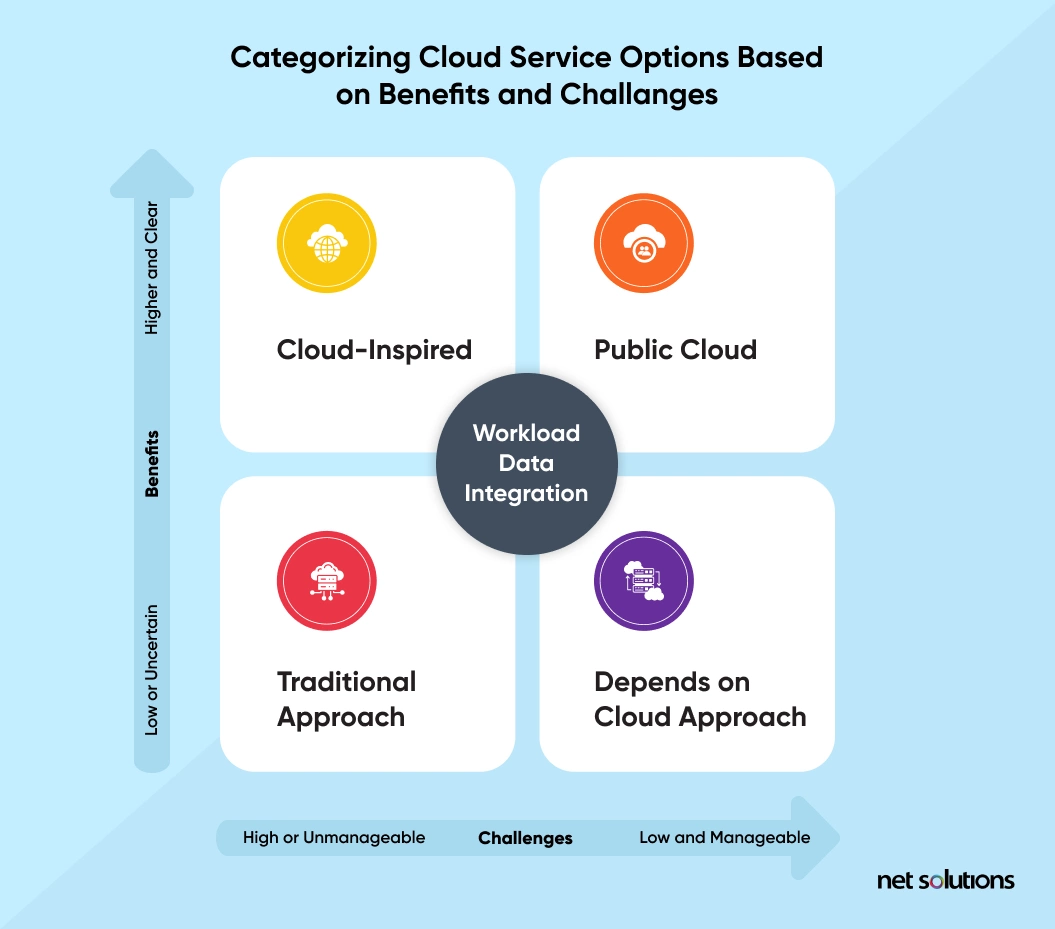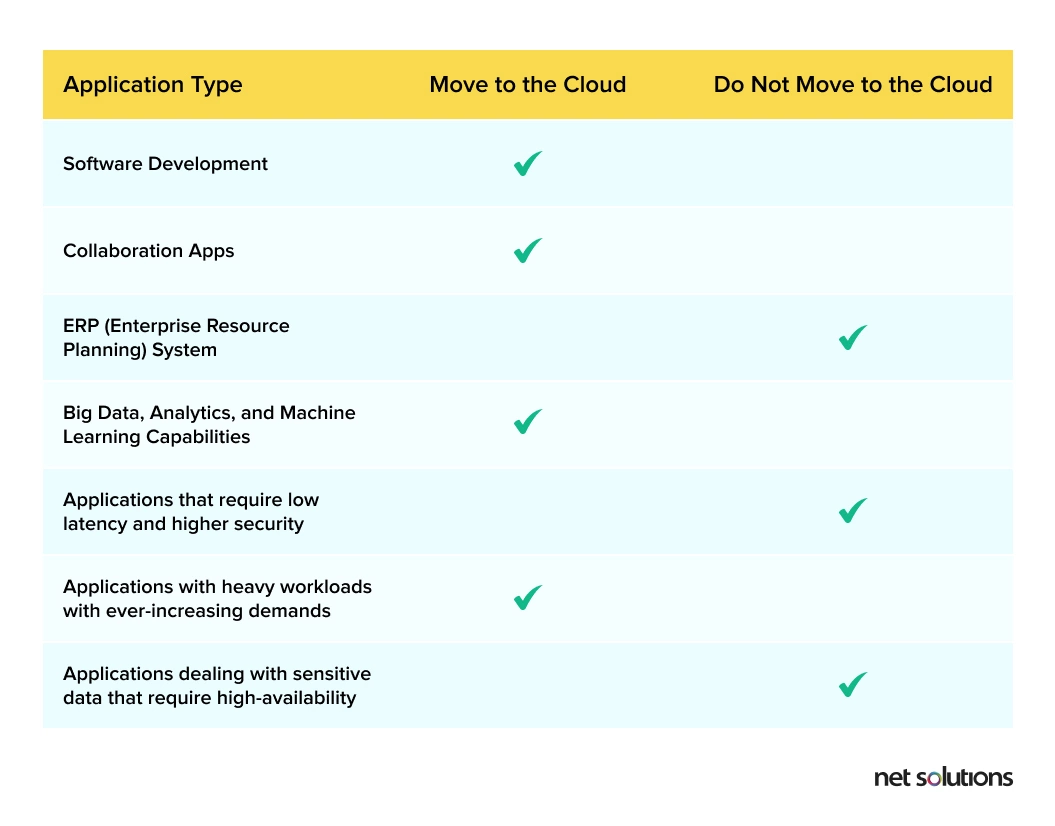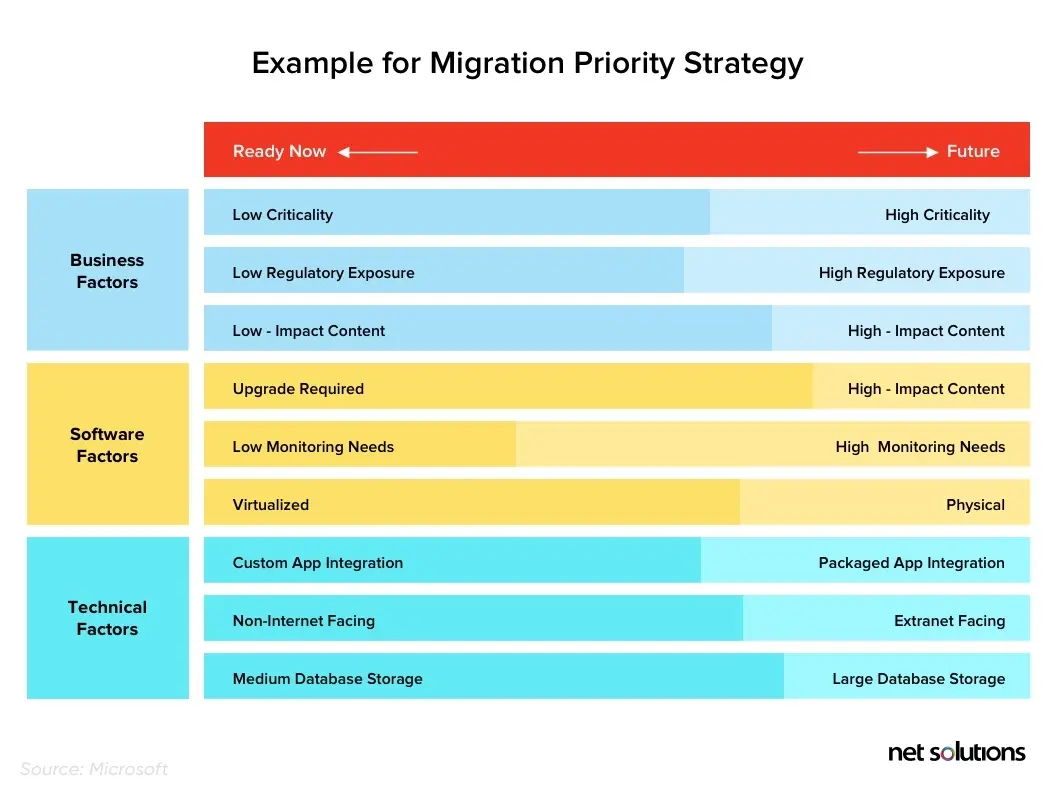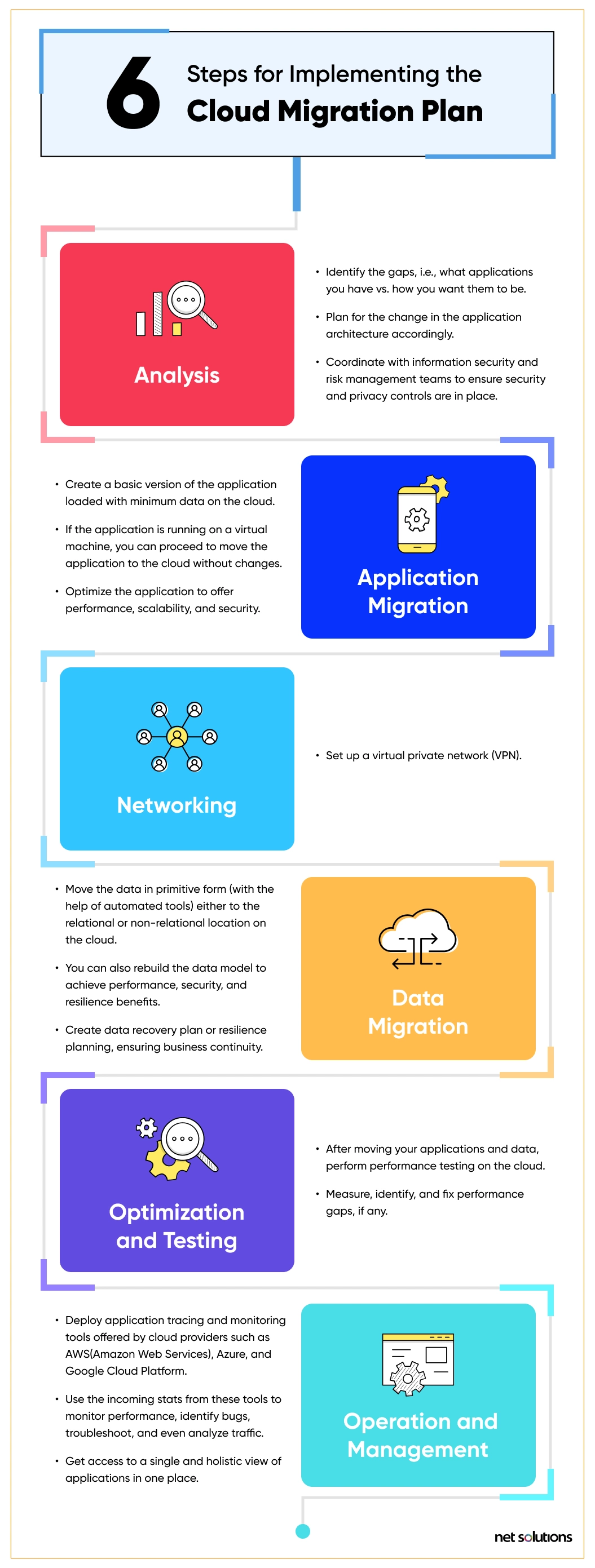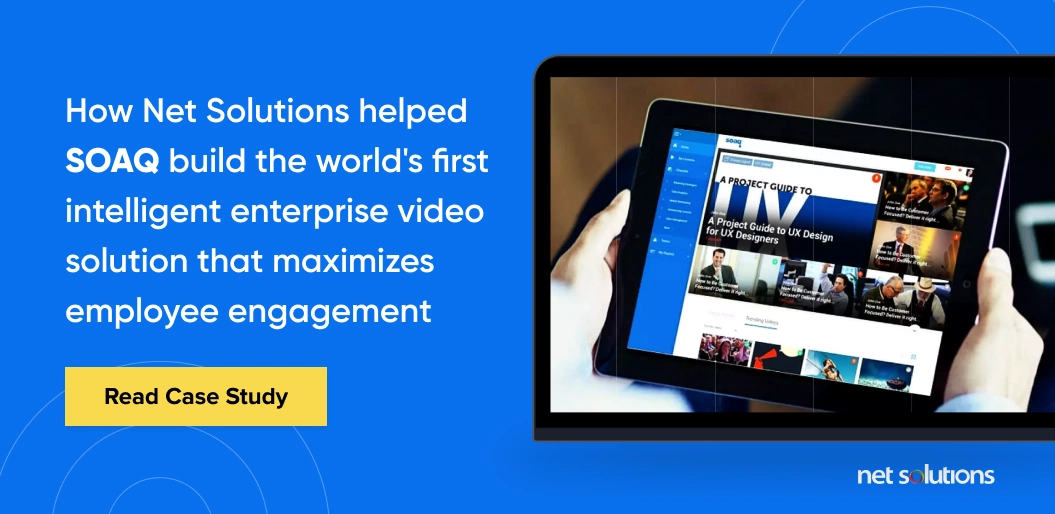Do you want to create a winning enterprise cloud strategy but don’t know where to start? This blog highlights all the steps you can take to plan a successful cloud migration and adoption, starting from creating an enterprise cloud strategy team to finally moving ahead with migration.
A cloud strategy is a concise outlook on the role that cloud computing plays in an organization. An organization with a robust cloud strategy has a more rational approach to cloud usage, weighing both the advantages and potential disadvantages of using the cloud, aiming to maximize the former while keeping down the latter.
93% of technology leaders said they were “mostly cloud” in some form, 10% more from two years ago (83%). 48% said they’re primarily hybrid, 8% more than in 2020. Also, the number of technology leaders saying they’re primarily on-premises has dropped by 7%. – 2022 State of APIs and Applications
As businesses move towards a new digital paradigm, where they are trying to raise their innovation capabilities to stay relevant in today’s Darwinian digital transformation era, the adoption of cloud services is accelerating rapidly.
However, despite the increasing popularity of enterprise cloud solutions, organizations continue to flounder with prioritizing, building, and implementing a result-driven cloud strategy.
Why Do You Need a Cloud Strategy?
An enterprise cloud strategy ensures fewer hindrances along with the cloud migration and adoption journey while maximizing business benefits. It indicates the “why,” “how,” and “what” of cloud adoption. The absence of an enterprise cloud strategy leads to siloed technological solutions, thereby exposing the organization to risk from substandard configured environments.
“Organizations that do not have a high-level cloud strategy driven by their business strategy will significantly increase their risk of failure and wasted investment.”– David Cearley, Vice President, and Gartner Fellow
Devising a cloud strategy starts with analyzing your organization’s current status, deciding on a cloud migration strategy that will suit your business and functional requirements, and determining how this cloud digital transformation wave will change enterprise dynamics.
The purpose of crafting a sound cloud strategy is to:
- Define the business outcomes your organization seeks and its roadmap
- Identify the key benefits of adopting the cloud technology
- Determine the services that will be built internally and those that a public cloud partner will provide
What are Different Types of Cloud Strategy?
You could choose from various cloud strategies available, but your final decision should align with your business needs and scaling capability.
Let’s see what each cloud strategy implies:
1. Single public
In the Single Public cloud strategy, computing, cloud storage, and software are made available by the cloud provider on a pay-as-you-go basis, i.e., you only pay for what you use. Providers manage millions of data centers worldwide in the public cloud to maintain all-time availability and throughput.
The public cloud strategy is beneficial for enterprises looking to save on maintaining legacy infrastructure while having an opportunity to focus on core business functionalities.
2. Single private
It is a strategy where the cloud you host your data and applications explicitly belongs to you. The cloud provider’s technology stack that matches the business needs is hosted in an on-premise data center.
The private cloud strategy benefits enterprises that cannot risk moving critical data off-premises and are highly concerned about data security.
3. Hybrid cloud
A hybrid cloud combines private and public clouds. Enterprises prefer a hybrid cloud strategy as it is the best deal, and they can maintain some applications on-premises while moving others to the public cloud.
All enterprises are in a hybrid state at one point when migrating to the cloud. This is when you have moved some applications to the cloud, and some still run on-premises.
4. Multiple-Public
It is a cloud strategy where an enterprise relies on more than one cloud service model (IaaS, PaaS, SaaS) of the same type ( private or public) from more than one cloud provider. Some understand that a multi-cloud strategy is the same as a hybrid cloud, but it is not.
This is the best, and the most popular strategy enterprises rely upon, as it offers an orchestrated cloud experience.
| Characteristic | Single Public Cloud | Single Private Cloud | Hybrid Cloud | Multi-Public Cloud |
|---|---|---|---|---|
| Ownership | A third-party provider | An organization or third-party provider | Combination of public and private cloud providers | Multiple third-party providers |
| Infrastructure | Shared by multiple organizations | Dedicated to a single organization | Combination of shared and dedicated infrastructure | Multiple shared infrastructures |
| Scalability | Highly scalable, with resources available on demand | Scalability depends on the organization’s investment in hardware and infrastructure | Scalability is a balance between public and private cloud resources | Highly scalable, with resources available on demand from multiple providers |
| Security | The cloud provider manages the security | Security is governed by the organization or a third-party provider | Security is a joint responsibility between the organization and the cloud provider | Cloud providers manage security |
| Cost | Pay-as-you-go pricing model, cost-effective for small and medium businesses | Higher upfront costs, cost-effective for large businesses | Cost-effective for organizations with fluctuating resource demands | Cost-effective for organizations with needs that require the services of multiple providers |
| Customization | Limited customization options | A high degree of customization | moderate degree of customization | A moderate degree of customization |
| Compliance | Compliance with industry regulations is the responsibility of the cloud provider | Compliance is the responsibility of the organization or a third-party provider | Compliance is a joint responsibility between the organization and the cloud provider | Compliance is the responsibility of each cloud provider |
| Flexibility | Limited flexibility, as the infrastructure is owned and managed by the cloud provider | A high degree of flexibility, as the infrastructure is owned and operated by the organization | A moderate degree of flexibility | A high degree of flexibility, as multiple providers offer various services |
5 Key Elements of a Cloud Strategy
Here are five key elements that define a cloud strategy:
1. Your cloud strategy must follow your business strategy
Cloud is a powerful tool for achieving and accelerating your business objectives, but only if your cloud strategy closely aligns with your business strategy. Otherwise, you would only waste your time, money, and effort.
Here are the other reasons why your cloud strategy should closely follow your business strategy:
- When your cloud strategy aligns with your business strategy, you can ensure that your cloud investments align with your overall goals.
- By aligning your cloud strategy with your business strategy, you can identify areas where cloud investments can help reduce costs and improve efficiency.
- When your cloud strategy aligns with your business strategy, you can ensure that your cloud investments support your business’s agility and responsiveness.
- By aligning your cloud strategy with your business strategy, you can identify areas where cloud investments can help differentiate your business and improve your competitive position.
- When your cloud strategy is aligned with your business strategy, you can ensure that your cloud investments meet your business’s security and compliance requirements.
2. Assess cloud-related risks
Risk management is essential to a Cloud strategy. By assessing risks and formulating cloud exit strategies to mitigate them, you make your journey to the cloud successful. Agility, security, supplier, compliance, and availability risks are the five types of risks that enterprise architects and I/O leaders must assess while setting a cloud strategy.
3. Cost reduction shouldn’t be the only driver for cloud adoption
While reduced costs are the primary reason behind cloud adoption, they shouldn’t be the only reason you switch to the cloud. Here are a few reasons:
- By focusing only on cost reduction, you may miss opportunities to innovate, improve your customer experience, and create new revenue streams.
- If cost reduction is your sole purpose, you may choose a cloud solution that doesn’t offer the functionality and flexibility to meet your unique business requirements. As a result, you may save some money initially but negate any cost savings.
- By focusing on cost reduction alone, you may overlook important risk management considerations, putting your business at risk.
You must take a holistic approach to cloud adoption. This way, you can minimize risks and maximize the benefits of the cloud.
4. You must plan for various routes to Cloud
Various possible routes to the cloud exist. Out of these, here are the six most popular ones (also called the 6Rs of Cloud computing):
- Rehosting: Also called “lift and shift,” this approach involves moving existing applications and data to the cloud without significantly changing the underlying architecture.
- Replatforming: In the re-platforming approach (also known as “lift, tinker, and shift”), we adjust the application architecture to take advantage of cloud-native features, such as auto-scaling and load balancing.
- Repurchasing: In repurchasing, we replace existing applications with cloud-native alternatives.
- Refactoring: In the refactoring or re-architecting approach, we redesign and re-engineer the application architecture to be cloud-native.
- Retiring: The refactoring approach involves decommissioning or archiving applications that are no longer needed or relevant.
- Retaining: In this approach, we keep some applications on-premises and only migrate specific workloads to the cloud.
The right approach to these depends upon your business routes. However, you must be prepared to ensure that cloud adoption happens smoothly.
5. Understand the shared responsibility model of the cloud
The shared responsibility model is a fundamental change with the adoption of cloud computing. It means that both the cloud provider and the customer are responsible for ensuring smooth operations on the cloud.
The cloud provider’s responsibility is to offer the services, while the customer’s responsibility is to leverage those cloud services in their processes to get desired results. Customers must clearly understand them to ensure they can reap the maximum cloud benefits.
Key Cloud Strategy Principles
Crafting your enterprise cloud strategy around the key cloud strategy principles is vital for successful cloud adoption. Several potential cloud strategy principles define a cloud strategy. Some of them are inexpugnable — for instance, whether a cloud strategy will be application-by-application or workload-by-workload exercise (workloads are groupings of applications).
A few other principles of an enterprise cloud strategy are:
- Cloud-First: It does not mean everything goes to the cloud. We will discuss it in the coming sections.
- Buy Before Build: Evaluate various commercial off-the-shelf software before building a custom solution.
- Best of Breed: Best of breed wins the cloud adoption.
Questions to Answer when Building a Cloud Strategy
Here are some commonly asked questions that align with enterprise cloud strategy.
1. What is a cloud-first strategy?
The U.S. government initially used the Cloud-first term almost a decade ago.
A cloud-first strategy implies that if an organization intends to invest and fulfills relevant criteria for them, the default option to build or migrate their workload will be in the public cloud. They would then move back from the public cloud to other potential options like on-premises, hosting, or co-location. Remember, the cloud-first strategy does not mean cloud-only.
By 2025, 85% of enterprises will have a cloud-first principle. – Gartner
2. Is multi-cloud strategy mainstream?
A multi-cloud strategy allows benefiting from the best services that popular cloud providers like AWS, Azure, and Google platforms provide. Yes, a multi-cloud strategy is the new normal. Even Flexera’s state of cloud report for 2023 says that 87% of organizations use the multi-cloud strategy, i.e., a combination of multi-public and hybrid cloud.
3. How are cost and time related when implementing an enterprise cloud strategy?
The time you take to devise a cloud strategy framework, followed by its implementation, decides the corresponding expenditure. Three migration phases are classified as — aggressive, moderate, and slow. Here’s what each of them implies:
- Aggressive: Moving 50% of your legacy infrastructure to the cloud in one year. An aggressive cloud strategy plan will prove beneficial in the long run but involve higher risk and migration costs.
- Moderate: When you decide to move about 30% of your legacy infrastructure to the cloud in one year.
- Slow: When you decide to move about 10% of your legacy infrastructure to the cloud in one year. The cost of migration will be less, but it will affect the organization’s overall growth due to its slow transformation.
If you ask for the best cloud strategy that reduces costs and increases efficiencies, the answer would be a moderate strategy to move to the cloud while maintaining a balance.
4. What is a cloud strategy framework?
A vital parameter of a successful cloud strategy is crafting an enterprise cloud strategy decision framework, which assesses the benefits, risks, and challenges of adopting the cloud technology for specific application scenarios. To evaluate this cloud strategy framework, all the organization’s stakeholders must become part of the team.
Use the following decision matrix, introduced by Gartner, and place “challenges” along the x-axis and “benefits” along the y-axis.
Enterprise Cloud Strategy Roadmap: The 5-Step Plan
Creating an enterprise strategy is essential before migrating to the cloud. The process may vary from enterprise to enterprise. However, here are some steps that every enterprise cloud strategy should follow.
Step 1: Create an enterprise cloud strategy team
Creating a cloud strategy team ensures your cloud adoption journey stays on track. The CTO of your enterprise generally heads this team and comprises IT and networking teams.
The team is responsible for building a cloud strategy roadmap and checklist, ensuring its successful implementation, and communicating with the stakeholders occasionally. The cloud strategy team also is the key decision-maker when choosing a cloud deployment model, cloud migration strategy, and cloud providers.
The core responsibilities of the team can be summarized as follows:
- Making faster and more informed decisions when choosing from among various cloud strategies
- Maintaining communication with the stakeholders
- Choosing between applications that need to be moved to the cloud vs. the applications that will be maintained on-premises
- Framing and implementing a cloud strategy implementation plan to address hindrances toward successful cloud adoption
- Analyzing, planning, and managing the cloud as new realities evolve
Step 2: Thoroughly analyze your applications
Before framing your enterprise cloud strategy, analyzing applications and their relevance to the cloud becomes imperative. Decide between applications that need to stay on-premises vs. those that need to move to the cloud.
For instance, mission-critical applications ought to stay on-premises. The same applies to applications that are outdated and need to be scrapped. Moving such applications to the cloud will only add to the costs with minimal to no benefits.
In short, if the risk of moving a particular application to the cloud is higher, maintain it on-premises.
Step 3: Build a hybrid cloud strategy roadmap
Not all applications and services can be moved to the public cloud. Some are maintained on-premises on a private cloud, but some need to be abandoned as they are no longer valuable. Hence, you must create a hybrid cloud strategy roadmap that aligns with your business goals and help you benefit the most from a hybrid cloud environment.
Here are two strategies you can use at this stage:
a. Rightsize
Goal: Modernization with the Microservices Architecture
Enterprises must distinguish cloud migration from simply rehosting their applications from on-premises to the cloud, i.e., lift and shift. However, there are better solutions than this strategy, as optimizations are essential to adjust to the new environment.
The applications need to be reconfigured so that they can be cloud-ready, i.e., they need to be resized. This is possible by breaking down the monolithic application structure and adopting the microservices architecture.
Microservices architecture focuses on developing an application with smaller modules that are loosely coupled. This reduces the cost and effort involved in cloud adoption while adding flexibility to iterate whenever necessary.
A cloud strategy example — Netflix took almost seven years to transform its applications and adopt the microservices architecture to move to Amazon Web Services. The reconfigured application structure maximized service availability and reduced IT costs as opposed to on-premise management of resources.
b. Retire
Goal: Looking for a Corresponding SaaS Solution
It is better to look for alternative SaaS solutions for applications that must be updated or should be retired, as identified in the above step. This is preferable if you wish to trim down the time to successful cloud adoption. It is not only cost-savvy but also saves you from the effort of developing an application all over again.
Some third-party SaaS product development companies are available that help develop applications that suit different business needs. The cloud strategy team must identify these providers and weigh their pros and cons, market share, and pricing before finalizing the best fit.
For example, your relation management software that is getting obsolete with time can be replaced with available third-party CRM software online.
Step 4: Reskill and upskill
Once you implement your cloud strategy, the routine IT operations will significantly shift. This will further lead to a change in the roles and responsibilities of the IT department, for which your enterprise should prepare in advance.
” The new model is, ‘You own it, you build it,” giving single teams ownership of every stage of development and requiring that IT and the business operate in lockstep with one another.” — Charlie Li, Capgemini’s chief cloud officer
Reskilling and upskilling are safe strategies to implement where everybody across the enterprise can learn and adapt to the new working environment. It will reduce burnout and productivity, the greater agenda of any workplace.
As the traditional roles will continue to prevail in the background, the newer cloud-driven roles will evolve and hold precedence. Here is a chart that shows how enterprise roles will change after implementing the cloud strategy.
| Traditional Role | Cloud-Driven Role |
|---|---|
| UI, UX Designer | Process Engineer(ensures orchestrated and hindrance-free loud experience) |
| Developer | Cloud Architect (leverage cloud for providing business benefits)
Engineering and DevOps (ensures continuous deployment) |
| Tester | Data Scientist (Provides insightful data that offers value) |
| Data Analyst | Data Scientist (Provides insightful data that offers value) |
| Applications Monitoring and Support | Engineering and DevOps (ensures continuous deployment) |
| Network Engineer | Engineering and DevOps (ensures continuous deployment)
Edge and Wireless Networking (provides secure remote access) |
| Solution Manager | Relationship Manager (cloud advisor)
Business Architect (offers the best use of cloud assets) |
Another significant change in the organization is the amalgamation of — the development and operations departments, thus paving the way for the DevOps culture.
Introduction to DevOps
DevOps is a combination of cultural philosophies, practices, and tools that helps organizations deliver applications and services quickly by fostering collaboration between the development and the operations team. The new reality has led to a cross-functional team setup, bridging the communication gap across the organizational culture.
With the cloud, deploying new applications or new features to the existing applications on the cloud becomes normal. You must appoint the development team to create applications using agile development practices.
Now, as the development teams step in, so would the testers. Thus, breaking the silos that exist between developers, tests, and operations departments.
The takeaway is that you must prepare, reskill, and upskill your staff to know their changing roles and responsibilities and train them for what lies ahead. This is essential to ensure that cloud strategy best practices are followed.
Step 5. Implement the cloud strategy
When implementing the cloud strategy, the first thing that needs to be decided is what part of the legacy infrastructure will be moved first. It is not a one-time effort but a long-term initiative.
For instance, you are moving a large pile of books from one room to another. Carrying them all at once will be challenging, and the burden might be too much to handle. Moreover, you might fall too.
On the other hand, if you carry only limited books at a time, you can easily take the weight while ensuring the pile stays intact. The same is the case with cloud migration. You need to lift and shift partitions in partitions. But the operations team must prioritize what needs to be moved based on your business requirements.
Here’s a migration strategy prioritization example by Microsoft:
According to the diagram above, choosing low complexity, low business risk workloads should hold priority. If you start small, you can learn and implement better regarding complex and high-risk workloads.
Ideally, this should be the order of movement in the cloud:
- First Phase: Development and Testing (DevTest) environments, Web apps, new products and solutions, redesigned solutions and products
- Second Phase: Regulatory solutions, High Input/Output online transactional processing systems (OLTP)
- Third Phase: Secure high-value assets (HVA) systems, public key infrastructure (PKI) systems, and legacy source control systems
Next, follow the cloud migration plan when migrating each workload to the cloud:
Leverage Our 20+ Years of Experience to Build a Successful Enterprise Cloud Strategy
Cloud adoption is not a small initiative but a significant decision that would evolve how your business operates. Hence, it requires strategy, patience, and expertise. An enterprise cloud strategy ensures a fool-proof execution of the cloud migration and adoption process, but only if you plan it wisely. The more strategically and patiently you move, the better the implementation and success of your enterprise cloud strategy.
That’s where strategy consultants step in. By helping you build you lay out a cloud migration, transformation, adoption, technology, and security strategy, they ensure that you can safely adopt and migrate to the cloud.
At Net Solutions, we’ve helped many enterprises leverage the power of the cloud to future-proof their business. From planning a cloud migration to fully customizing the cloud to enterprises’ unique business needs, we’ve done many things for these technology leaders and can do for you.
Building Soaq’s flagship product: A cloud-enabled enterprise video platform that maximizes employee engagement
A team of people who excel in technology-based learning and development conceptualized and founded Soaq in 2015. Soaq CEO Daniel Wolfe carries a vision to help organizations master internal communications.
Soaq had a vision, and they turned to Net Solutions to build a corporate communication platform, complete with machine learning, to recommend relevant videos, flexible access systems, and a highly intuitive interface.
Know how Net Solutions helped Soaq build the world’s first intelligent, widely-adopted enterprise video solution – making Gartner’s List of Cool Vendors in Content Services.
Frequently Asked Questions
-
01
What are the five essential elements of an enterprise cloud strategy?
Here are five essential elements that constitute an enterprise cloud strategy:
- Clear Objectives and Goals: Clear objectives will keep your enterprise cloud strategy on track and ensure you don’t lose focus.
- Comprehensive Security: Security is critical for any cloud deployment. Hence, your enterprise cloud strategy should include a comprehensive security plan that addresses all aspects of cloud security.
- Scalability and Flexibility: You must design the enterprise cloud strategy to support your organization’s future growth and changing needs.
- Governance and Compliance: Include a governance framework in your enterprise cloud strategy that outlines policies and procedures for managing cloud resources and data – including regular audits and assessments to ensure compliance with regulations and industry standards.
- Robust Data Management: Cloud deployments generate vast amounts of data, and you must have robust data management to manage and store the data securely.
-
02
What are the 4 C’s of cloud-native security?
- Code security: Ensure the safety of the software code from vulnerabilities and malicious attacks.
- Container security: Protect the containerized applications and their runtime environment from security threats and exploits.
- Cluster security: Secure the nodes and resources within a cluster to prevent unauthorized access, data breaches, and other security risks.
- Cloud security: Define a set of practices and technologies to safeguard cloud computing environments, including data, applications, and infrastructure, from security threats and risks.
-
03
What are the 3 types of cloud services?
- Software as a Service (SaaS): SaaS are the services offered at the application level. Salesforce, Canva, and Zoom are the primary examples.
- Platform as a Service (PaaS): Paas are the services offered at the middleware level. Google app engine and Openshift are some popular examples.
- Infrastructure as a Service (IaaS): IaaS are the services offered at the hardware infrastructure level. Some popular examples are AWS, IBM Cloud, and Microsoft Azure.
-
04
Why is cloud adoption essential?
Cloud adoption is essential for businesses for the following reasons:
- Scalability: With cloud computing, organizations can easily scale their IT resources up or down as needed, thus quickly responding to changing business needs and market conditions.
- Cost savings: Cloud computing can provide cost savings through pay-as-you-go pricing models, allowing organizations to only pay for their resources.
- Agility: Cloud computing can help organizations become more agile and responsive to market changes by helping them quickly develop and deploy new applications and services.
- Collaboration: Cloud computing allows collaboration among teams and individuals across different locations, enabling them to work together in real-time and share resources and data.
- Security: Cloud service providers offer advanced security measures and compliance certifications that are often beyond the reach of many organizations.


 Updated: May 5, 2023
Updated: May 5, 2023


